Using the Silver Line as the priming event, what would a transit network improvement program look like for NoVA?
Today's Post article, "Va. community once primed for streetcar struggling to find new energy," about the revitalization malaise that has set in the Bailey's Crossroads area of Fairfax County since Arlington County cancelled plans to build a streetcar line in the Columbia Pike corridor, and yesterday's Post article, "When commuting in the DC region, distance doesn't tell the whole story" which makes the point that in terms of traveling east to west the DC metropolitan transit network has many gaps reminds me that I haven't yet written a series of posts around the "Fantasy High Frequency Transit Map," created by Paul J. Meissner, incorporating ideas from both of us.
Also see the 2011 post, "Short term vs. long term thinking: transit, the Washington Examiner, Fairfax/Loudoun Counties vs. DC," which discusses how the Silver Line wasn't so much about providing access to the Dulles Airport as much as it was rearticulating the land use planning paradigm in the Silver Line transit shed (station service catchment area) for the 21st century and the desire to live in more urbanized places.
And the 2015 post, "Silver Line reshaping the commercial office market in Fairfax County."
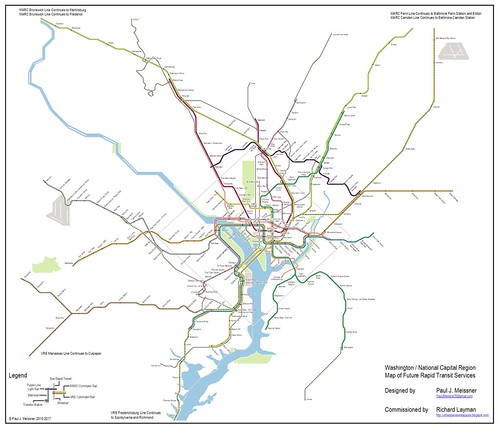
Washington/National Capital Region Map of Future (Potential) Rapid Transit Services. Designed by Paul J. Meissner, for the "Rebuilding Place in the Urban Space" blog.
Organizing principles for transit network expansion and improvement as incorporated into Paul Meissner's map. The basic idea was to shape the map with some general somewhat objective organizing principles. It wasn't just about drawing lines on a map, but trying to serve high use destinations, which is necessary to justify the investment.
For me it was first that the WMATA map only shows the subway lines, and it needs to show the railroad lines too, as is common in other cities with more frequent passenger rail service.
Second, the Metro Forward program doesn't do all that much for DC, so we need a better plan for transit expansion. Third, it was about trying to separate the blue and silver lines, and to some extent the yellow and green lines, to reduce "interlining" which ends up reducing capacity and decreasing reliability (see the discussion of this point here, "More on Redundancy, engineered resilience, and subway systems: Metrorail failures will increase without adding capacity in the core").
Fourth, at the same time using the separation of the lines to add capacity and service and intensification of land use by using the changes to bring about more high capacity service to more areas. And to intensify service by providing infill lines and stations.
For example, as discussed below, this concept would add 22 Metrorail stations to Northern Virginia.
But it also adds 26 stations in DC (note to Paul, on the Silver Line we're missing a station between West End and Thomas Circle, maybe 17th Street?), and 21 new Metrorail stations in Maryland.
Some of this is by extending some of the lines outward, and some is by adding lines within the current system footprint.
For Paul it was about using recommendations from adopted plans, as well as some key vision points, the likelihood of happening (which is why we had a tug of war between us about the Purple Line) as well as speed issues--he wasn't into "extending the Purple Line from Bethesda to Tysons" because it would be very slow if it isn't given dedicated right of way.
Paul also made keeping "a one seat ride to Downtown" a key principle in the design of the original Metrorail transit network, which is why he wouldn't accede to my changing the blue line so that it no longer would go directly into DC providing multiple station stops within the Central Business District. (Think of how the Blue Line truncates in this map, and a separate Brown Line emanates north from Georgetown--in the latest iteration, I wanted to combine these lines into a new Blue Line.).
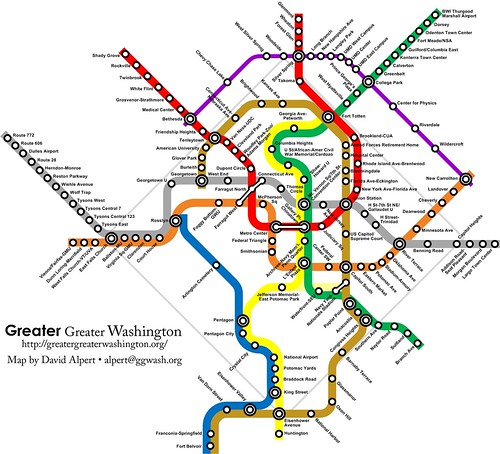
Note that these ideas presuppose significant changes in organization, planning and funding arrangements concerning the transit system as discussed in hundreds of past blog entries.
First, it would start by creating a new overarching "transport association" bigger than WMATA ("The answer is: Create a single multi-state/regional multi-modal transit planning, management, and operations authority").
Second, it would require different funding arrangements, again, beyond WMATA ("What to do about WMATA?, the DC area transit system: the Federal City Council says create a Control Board" and "Metrolinx Toronto: 25 potential tools to fund transit-transportation infrastructure")
Note that now "I am very afraid" that if WMATA gets dedicated funding as major stakeholders are arguing for, it will circumscribe the ability for other transportation improvements to be able to get funding.
Overarching recommendations:
1. Create the DMV Transport Association
2. Create regularized transportation funding mechanisms for the metropolitan area and region that transcend individual operators like WMATA.
Purple Line series as a model for what could be done in Northern Virginia. I have a series of posts on how complementary transit network improvements could be made simultaneous with the building and launch of the Purple Line light rail in Montgomery and Prince George's Counties:
-- Part 1 | the principles
-- Part 2 | the program (macro changes)
-- Part 3 | influences
-- Part 4 | Making over New Carrollton as a transit-centric urban center and Prince George's County's "New Downtown"
-- Part 5 | Creating a Signature Streets sustainable mobility road network in the core of Silver Spring (to come)
Silver Line as a priming event for improving the transit network in Northern Virginia. As with the missed opportunity (so far) to utilize the Purple Line as a way to push improvements across the transit network, the Silver Line should have been and still could be utilized similarly in Northern Virginia.
Of course, it should have been leveraged at the outset by DC as a way to build the separated Silver Line within DC, something I have been writing about since 2006 ("The Silver Line WMATA story that WJLA-TV missed"), which would have added an additional northern subway crossing across the Potomac River.
I don't have the same level of fine grained knowledge about NoVA that I do wrt Montgomery and PG Counties, so writing a super detailed piece comparable in scope to the Purple Line series is beyond me.
It is unfortunate that the improvements to the transit network from the Silver Line, a streetcar on Columbia Pike, and the expansion and improvements of the Virginia Railway Express weren't laid out as three parts of a complete package, with the whole being greater than the sum of the parts.
Recommendations
Refer to the discussion in Part 2 | the program (macro changes for more details on many of the points below referenced as part of the PL writing.
Note that the Phase 2 of the Silver Line is scheduled to open in 2020, so the time line as proposed wrt the Purple Line doesn't work in terms of Northern Virginia
for Northern Virginia
1. Separating the Silver Line from the Orange Line by extending the line south to Rte. 50 and then east along the street to Rosslyn. That would provide six new stations: West Street; Falls Church; Seven Corners; Arlington Forest; Ashton Heights; and Fort Myer. Continuing the Silver Line from its endpoint at Ashburn to Leesburg should be considered also, which isn't depicted on the above map.
2. Extending the Orange Line west, adding four stations: Fairfax City/GMU; Fair Oaks; Fair Lakes; and Centreville.
3. Extending the Yellow Line south on Rte. 1 to Fort Belvoir, adding four stations: Beacon Hill; Hybla Valley; Mount Vernon; and Fort Belvoir. (This should have been done as part of BRAC planning, something I first suggested in 2005.)
4. The map also acknowledges the planned infill Potomac Yard station on the Blue and Yellow Lines, and proposes an infill station, called East Potomac Park, serving the west side of the National Mall near Jefferson Memorial, within DC.
5. A new Pink Line rapid transit line (subway) is proposed serving Northern Virginia in the Columbia Pike corridor, with service to DC, adding eight stations in Northern Virginia: Lincolnia; Seminary Road; Skyline Center/NOVA Community College; Baileys Crossroads; Barcroft; Pike Town Center; Penrose Square; and Air Force Memorial. The heavy rail Pink Line addresses the malaise in the Columbia Pike corridor identified in the Post article.
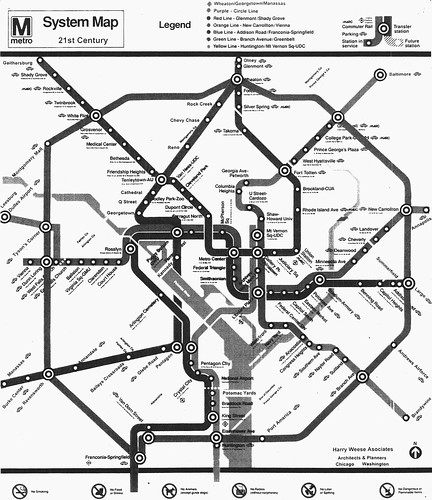
This c. 1990 WMATA proposed extensions map shows a line out Columbia Pike. Note the stations for Annandale and Baileys Crossroads. It proposed a terminus in Manassas.
The Pink Line is Paul's concept, and includes some of my input concerning service beyond Silver Spring in Montgomery County. Note that original system planning for the Metrorail envisioned a line like this out Columbia Pike, but unlike our line which continues past the Silver Spring Metrorail station, the WMATA proposal terminated there.
That's why there is the clump of high density apartment buildings in Fairfax County out that way, not unlike how the area around what became PG Plaza Metrorail Station bulked up starting in the late 1960s, in response to future plans for what became the Green Line ("Back to the Future," Washington Business Journal). From the article:
When University Town Center opens in June, it will offer the typical fare Washingtonians can't resist. A movie theater will beam the latest flicks onto 14 state-of-the art screens. Condos and apartments will overlook a central plaza dotted with art, fountains and natural greenery. Sushi and wine, burgers and brews will tempt taste buds.
It will be exactly how developer Herschel Blumberg envisioned it. In 1961.
Conceptual rendering for a BRT system on Leesburg Pike.
6. Integration of various Bus Rapid Transit improvements into a unified network (shown on the map as green lines). (In part, Item 10 on the PL list.)
7. Set the opening of the Purple Line as the deadline for the integration of the MARC Penn Line and VRE Fredericksburg Line into one combined railroad passenger service line ("A new backbone for the regional transit system: merging the MARC Penn and VRE Fredericksburg Lines"). (Item 13 in the PL list) Note that separately, MARC is planning to extend the Penn Line to Delaware (and/or alternatively, extend SEPTA service from Newark, Delaware to Perryville, Maryland).
8. Introduce bi-directional railroad service between DC and Fredericksburg in association with the combination of the MARC Penn and VRE Fredericksburg Lines into one integrated service.
9. Integrate the Crystal City railroad station into the ground transportation system of National Airport ("A brief comment on ground transportation at National Airport vis a vis VRE rail service") to better leverage railroad access to the airport, comparable to ground transportation and marketing services for the rail connection from the BWI MARC/Amtrak station to BWI Airport.
10. Integrate VRE/MARC fares into the SmarTrip/ CharmCard fare media system (Item 3 in PL list).
11. Extend the Purple Line light rail from Bethesda to Tysons, using dedicated right of way, including on the American Legion Bridge.
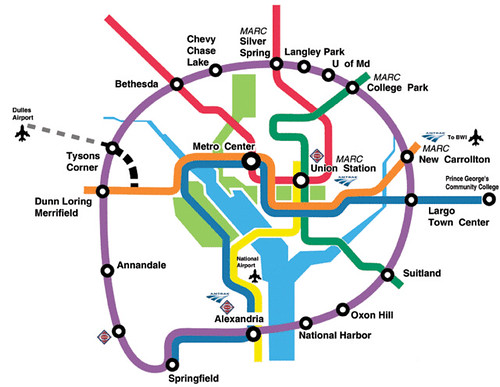
The original Purple Line concept connects the various heavy rail lines in Northern Virginia and Maryland, providing better east-west connections on the north and south sides of the transit network. Sierra Club Metro DC graphic.
The transit services in Raleigh-Durham use the same design scheme, but assigning a different color to each transit agency.
12. Consider a redesign and rebranding of the the metropolitan area's bus systems into an integrated family of transit agencies linked by a common graphic design treatment, comparable to that of GoTransit in the Raleigh-Durham area (Item 12 in the PL list).
13. Set the opening of the Purple Line as the deadline for the implementation of a full-fledged integrated Night Owl bus network for the DC metropolitan area (Item 14 in the PL list).
14. Provide integrated train arrival information screens at Metrorail, Light Rail, and VRE/MARC stations (Item 7 in the PL list).
15. Provide integrated bus arrival and departure information screens at Metrorail, Light Rail, and VRE/MARC stations and bus-only transit stations (Item 8 in the PL list).
16. Incorporate quantum improvements in bicycle facilities across the mobility network in association with the launch of the Purple Line (Item 16 in the PL list). This item has a number of components, including definition of a regional bikeway network, creating a regional bikeways map, creating a system of secure public bike parking stations across the region, etc.
17. Rearticulate transportation demand management programming and services in conjunction with the PL launch, including a unified network of "customer information centers" (Item 17 in the PL list). Arlington was the first jurisdiction in the area to launch "Commuter Stores," promoting alternatives to driving alone, in particular transit. Other jurisdictions including Fairfax County have similar programs. A complete network should created, rebranded, and relaunched along with the rebranding of the area's bus systems as mentioned in Item 11 above.
18. WMATA should upgrade its Metrorail station bus shelters (Item 18 in the PL list).
19. Create sustainable mobility districts and corridors as appropriate, complementing the transit network improvements, especially in the Tysons area, which is planned, but far behind in implementation. This is discussed in Item 19 on the PL list, and will be the subject of a dedicated post, using Silver Spring as an example.
Another example is WABA's proposal for the development of a cycle track network and concomitant improvements in the Arlington Boulevard corridor.
====
20. Note that railroad improvements are dependent on reconstruction and expansion of the Long Bridge, the CSX owned bridge that connects DC and Virginia. The bridge has two railroad tracks used by freight and passenger trains, and two Metrorail lines. It needs two more tracks, which are likely to come as part of a second new bridge span. This is a priority for DC and Virginia currently. (For Virginia, it is part of their "Atlantic Gateway" program.)
-- Long Bridge Project
Note that in the planning for this bridge, I don't believe it has been suggested but I think that there should be a dedicated bus transitway also, providing redundancy and increased capacity for bus transit service between DC and Northern Virginia.
And it will take a lot longer than 6 years, sadly, to build that bridge extension. But because all of Virginia's plans for railroad expansion are dependent on it, it will happen.
DC streetcar service used to have a turnaround loop in Rosslyn. Streetcar service in Northern Virginia used to continue into DC, but when a new Key Bridge was constructed, dedicated right of way wasn't provided to streetcar services, and these various lines were discontinued.
21. I would add a heritage streetcar service for the National Mall including service to Arlington Cemetery and Rosslyn, as discussed here, "A National Mall-focused heritage (replica) streetcar service to serve visitors is way bigger idea than a parking garage under the Mall" and "New DC Circulator route serving National Mall reminds us that we are neglecting connections from west to east and fail to adequately connect Georgetown to the National Mall."
22. And Georgetown BID's gondola proposal connecting Georgetown DC with Rosslyn in Arlington County, Virginia, which regardless of the creation of a separated Silver Line or a Pink Line, would make Rosslyn's Metrorail Station the equivalent of a DC-serving Metrorail station.
23. (I still need to write about it) adoption of the City of Alexandria wayfinding signage system as a regional best practice, and porting the system to other jurisdictions.
24. Incorporate the proposed VRE system improvements plan into this program.
-- VRE System Plan 2040
25. Incorporate transit services associated with the I-66 project, Transform 66, into this program.
-- Transform 66 in Northern Virginia - Outside the Beltway: FAQs
-- Transform 66 in Northern Virginia - Inside the Beltway
26. Improve funding for local transit in Prince William County. See "With sustained reduction in gasoline prices, will suburban transit systems lose ridership and revenue?"
27. Integrate the long distance commuter bus network into a unified system. This is somewhat the case wrt Maryland in terms of the route network but not in the branding of buses as service is provided under multiple banners/liveries, although the system isn't good with bi-directional service (such as from DC to Annapolis).
Northern Virginia has separate long distance commuter bus services for each jurisdiction: Loudoun County; Prince William County; and Fredericksburg. The first two are public agencies (Loudoun Transit, OmniRide), the latter service is provided by a for profit contractor. Each uses a different livery.
Perhaps like with how GO Transit in Ontario has both commuter bus and rail services and one common branding system, in line with my RACER concept for merging MARC and VRE ("One big idea: Getting MARC and Metrorail to integrate fares, stations, and marketing systems, using London Overground as an example"), the commuter bus network in Maryland and Virginia could be similarly rebranded as the RACER commuter bus network, and like with GoTransit in Raleigh-Durham, the rebranding could be launched in part with a common graphic design treatment across the now differentiated fleets of buses. (RACER stands for Railroad Authority of the Chesapeake Region.)
Bi-directional services should be added to certain routes.
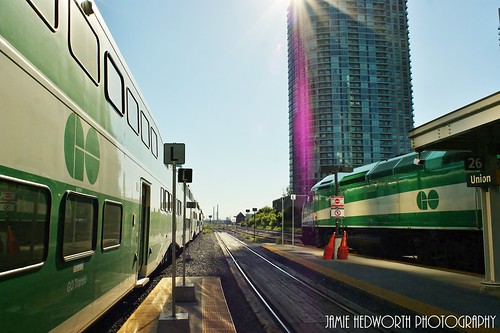
GO Train.
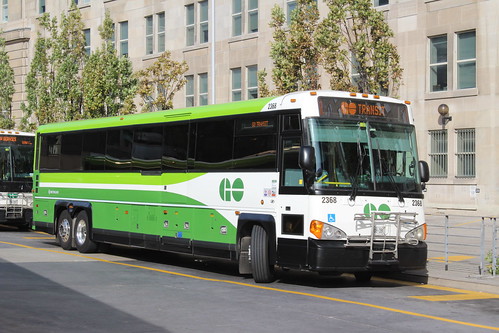
GO Bus.
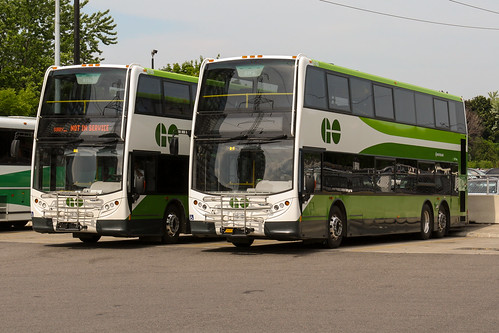
GO Bus also has some double deck buses (see "Making bus service sexy and more equitable") which is something that should be considered also.
In any case, rebranding and repositioning commuter bus service as part of the Washington metropolitan and regional transit network is worth considering as part of an integrated transit network improvement program.
Labels: busways/transitways, change-innovation-transformation, fixed rail transit service, public realm framework, transit, transit marketing, transportation planning, urban design/placemaking









27 Comments:
Rosslyn has changed a bit!
Integrating the VA commuter bus services is a good idea, but I suspect the funding streams don't push them towards that level of efficiency.
I see a reluctance of urbanists to engage the commuter bus issue at all. I know DC tried to rationalize the stops but still a mess.
Yes the Pink/Columbia Pike line would be more sensible as a heavy rail underground. Not sure it would solve the "problem" of Skyline. That is your classic low cost area and is actually thriving but the CRE owners aren't making that much. You have to separate the two.
(as opposed to H st or U st, which were just deserted).
Don't see anything on the Arlington transit way and it's limited success so far (one year?)
What both Rosslyn and Tysons need is a direct transit shot to Bethesda.
great post full of information. Any new transit lines should have express tracks.
you are spot on Charlie about Bethesda -Tysons rail transit- also hook it up to rockpile
Bethesda to Tysons via Purple Line was a struggle with Paul. He believes, rightly, that the distance is so great (not quite 12 miles), therefore LR at normal LR speed, especially in mixed traffic, is way too slow.
I think doing it like how it is in a lot of Seattle, underground, is the way to go, at least for that segment. Apparently the top speed if you get the right equipment, is about 65 mph.
I was thinking today, and I guess I'll add it in, if VA and MD were to work together on HOT lanes for 495, especially the Legion Bridge, and the 270 corridor as an integrated project a la (OC and Riverside), that you could require inclusion of dedicated ROW, ideally underground, for the LR.
(there is the issue that HOT lanes promote SOV trips, but if it were definitively linked with transit expansion, TDM, and corridor management, it is acceptable.)
WRT the comment about Rockville, I suggested in the series on corridor management in the I-270 corridor that you could add in the freeway ROW a spur for MARC to Bethesda, but I suppose that doesn't really make sense. I guess the line crosses 270 around the ICC.
I don't know if Maryland and DC are up for a crossrail type project to create a spur from the proposed White Flint station down to Bethesda, Georgetown-Rosslyn, and then if you want to Tysons out I-66 (I suggested something like that from Union Station to Tysons, but I talked to an Amtrak person and they said they studied tunneling to downtown from Union Station and it isn't possible).
I suppose you could use one of those diesel-electric locomotives and just run electric in the underground portion.
Reading Richard Florida's new book, it seemed very clear that the PL should be seen as a social inclusion and economic inclusion mechanism, primarily for PGC, but not exclusively.
It should be a metropolitan priority.
Transit expansion along these lines is the same thing. SO I think the Pink Line would be ok.
The more transit, the less it would be exclusive, and rents wouldn't be driven up as high.
That being said, the proposed CDC that I suggested (that should be one of the posts in the PL series, damn, just reiterating what I wrote before) to buy and hold properties to help maintain affordability, among other tasks (fund other development, including intensification, as well as new affordable housing, placemaking improvements, etc.).
wrt Metroway, I thought about mentioning it and Rte. 7 initiatives specifically, but that post is cited in the original PL post.
The thing about Metroway is that as people wrote on GGW (I haven't read it for a month, have I missed anything big?) that it should probably go to Rosslyn. What do you think about that?
Were I writing a deeper post, I'd say create a BRT network, decide on a brand for the transit network generally, and use it across the system, including a subbrand for BRT. Metroway is as good as any.
But it should be something like Go Rail/Subway/Tram, Go Bus, Go Commuter Bus, etc.
Or RACER...
I used to be somewhat strident about planning for parking, and maybe for commuter bus, but now realize/accept/ compromise recognizing if you don't plan and integrate, you waste resources and foster more SOV trips or congestion.
I'd start with mapping (a la Hamburg). Of course, the Germans, by having a defined hierarchy and common branding for transit:
U for Underground
S-Bahn for Commuter Rail
Bus ...
it gets trickier for tram/light rail (Tram and/or Stadtbahn).
In 2005, I went to a conference in Annapolis and I was able to reverse commute using the Commuter Bus from New Carrollton to Annapolis.
But with the recession, they dropped a lot of those services, including that one.
... I thinkmy recent picking up a Trains Magazine from 1956 affected me. To get to Bethesda, people should just transfer to the Red Line...
Speaking of that magazine. I bought it because the cover story was about the locomotive created to enable the underground service for Penn Station, a special electric locomotive using steam engine driving principles. But it had a great editorial about the decline of passenger rail (because of a 45% rise in the charge for using Pullman roomettes) and an article about then new passenger rail cars, which became standard.
The editorial had a great line that is fully relevant to transit:
Railroading is not many lines but one institution in the mind of the public ...
(That's how transit is to some extent. People want one integrated system, or at least, one integrated system would be a lot easier to use.)
sure, railroad is a network and the value is in the network.
Sort of explain problems about bus transit, which is not a network based effect.
In terms of expanding it to Rosslyn, Arlington needs better N-S transit. Rosslyn to Pentagon/CC is ok, but further out becomes a problem with bad transfers.
RE: Bethesda, your maps has a streetcar from Gtown to FrndShip heights. The office area is Rosslyn, not Georgetown.
Fantasy maps are a GGW speciality, or were. They seem to be giving up on content and focusing on advocacy. And not very useful advocacy.
Read the review of Flordia's book, agree on some levels, but i think he constantly gets causation backwards.
Ubiquity of uber type pooling services may destroy transit and bus.
Take the (proposed) u st circulator extension. Will be very hard to compete on price/service with a uber pool. Yes I know the numbers there are not real.
DC has turned into an uber snakebite. I have never been so afraid of driving (on my last 3 mile trip I counted at least 10 near misses, and I suspect they were all ubers).
I've made the argument a few years ago that in 15 years of living in DC area. I have maybe 4-5 bad experiences with cars as a pedestrian. I am getting 4-5 a day now. I don't ride bike share anymore (it gave me a bad knee) but would also be afraid of riding of a bike.
1. Yes, value in the network. That will be the basis of some comments I make on the Virginia State Rail Plan. They want to focus on the existing lines, failing to recognizing that adding back missing elements of a more robust network will have significant positive effects across not only the rail network but the transportation network.
2. I disagree with you (and don't) about UberPool. Not that it doesn't have a role to play, it does, in terms of enabling lower cost transit, what I call tertiary transit in my network typology but in the trade increasingly it is called "microtransit."
I see Via cars a lot in Columbia Heights when I pass through there. It's a route. It's microtransit or intra-neighborhood transit or the equivalent of taxi collectif a la Montreal.
It's fine. It complements the network.
Where I agree with you is in places where the transit network isn't particularly robust and doesn't have a strong foundation, isn't built on heavy rail at the base. E.g., here Metrorail is the foundation. In most US cities, they just have a bus network. And I can see pooling services having a deleterious effect on transit there, especially in higher income areas.
3. wrt your point about N-S in Arlington ... I don't have your knowledge, but you've made this point for years. I thought about it when writing the post. Frankly, I should rewrite with two additions, this being one.
Comparable to my point in the PL post about rebooting PG Transit, when writing this post I considered a separate point about redeveloping the Arlington bus network in terms of N-S linkages and these additional rail lines in the network.
4. wrt "ride hailing" and safety, the problem or a problem is the app (it's a form of distracted driving, e.g., problems with delivery based services and accidents-deaths have existed for years) and the likelihood that most of the drivers aren't likely to be city residents, so they aren't inclined to be concerned about pedestrians, nor familiar with driving in environments where pedestrians are preponderant, and also dependent on the app for directions and not knowledgeable on how to get around, not to mention under the "taylorism" gun of efficiency, monitoring, metrics, etc.
The reason I am not down with Uber and similar services is that they are about promoting SOV trips, not as an element of a sustainable mobility network, but instead of it. Therefore, they are a congestion promotion element, about personal mobility, not a congestion reduction element integrated into a sustainable mobility platform/product service system.
wrt safety, the best way to do it is to have less opportunity for car-ped/cyclist interaction. Uber adds to it, doesn't reduce it. What I call "designing conflict in." When the point of planning is to "design conflict out."
WRT Florida's book, it's not scintillating but worth reading. You can borrow my (review) copy if you want.
A big point is that we do have to reduce our land use restrictions, but judiciously.
His best discussion, still subtle, is on the value of transit, transit as the enabler.
But Belmont is way better at all those points. When _Rise_ first came out I said it was applied Jane Jacobs. Now I know a bit more about this stuff, and Jane Jacobs was more about discussing "agglomeration economies" which is Alfred Marshall (not that I have read his works).
You might like the book because Florida uses "your" externalities word a lot.
But it all comes back to the cities as a technology for maximizing the value of and opportunities for exchange.
He isn't as direct as he should be about transportation and the car, but he does make a good point that at about 5-6MM residents, the marginal benefit for car-centric mobility systems becomes negative. (He doesn't say it as an economist.)
The transportation aspect is key to the argument. Basically, the car disconnected the absolute necessity of concentration of commerce. Commerce dispersed to the suburbs, connected by the car. Business was less concerned about agglomeration economies.
Now, and this isn't discussed in the book at all, with a more globalized economy and the impact of digital connection and commerce on "everything", maybe it is the case that agglomeration economies and connectedness matter much more again, and the car has been superseded.
... I had to drive Suzanne to work this morning (in Rockville) and we passed various roads with Mill in their name, and we talked about Veirs, etc. She said "lots of mills." I said "Rock Creek." But then transportation was very expensive, it was expensive to ship things longer distances. So commerce was much more localize. True for manufacturing too. In the late 1800 and early 1900s e.g., you had stove manufacturing on a "distributed" basis because they were heavy. With the spread of railroad transportation, the companies were acquired and consolidated. (The same happened in most industries, including beer, etc.)
The car was enabled by the Interstate highway network, which dispersed commercial districts from the core, e.g., your Fairfax groupings or the I-270 or I-95 business districts in Maryland.
But the car-centric network seems to have reached its peak efficiency.
... anyway, in the book he repeats the point you've made a lot that because of lousy commutes (or bad Metrorail in our case) more people have moved back to the center, just to be closer to jobs and less dependent on the car or transit to get to them. (DC is an odd exception in that our center still is a major employment center.)
will be writing some posts, not sure if a full review.
recently back from LA and while there I noticed how aggressively LA is pushing grail transit and construction of new lines all over the city. It is very impressive and a number of areas of LA have new pedestrian activity whereas once they were primarily car oriented
ANON -- this is relevant to what I want to write about transit wrt the new Richard Florida book.
It reiterates my point about Fairfax and Loudoun and the Silver Line not being about Dulles Airport, but about being positioned for 21st century economic activity.
the same is the case for LR expansion programs in LA, Seattle, Denver, Dallas, and existing programs like in Salt Lake.
The thing is putting in place the right LU and intensification programs to leverage those investments and bring about the ROI and change in Transpo and land use practice. Otherwise, you don't get much return.
LA CA is really impressive- despite the freeways and squalid car culture- there is a strong urbanism there and it has clearly improved vastly since I last visited back in the 90's. Neighborhoods have been revived in the city and prosperity seems to be rising in all quarters there. Also- I checked- and now Chicago has overtaken DC's metro for second busiest in the USA. Our WMATA numbers are way down and support has been flagging for transit here- which is really absurd and backwards. The very thing that has generated the revival of the center of DC is left out to rot because the governments here cannot get their acts together. DC is in so many ways ahead of the rest of the USA but people here take all of the great things about it for granted and do nothing to help or maintain anything.
- word -
more on this subject to come.
would be great if DC could build a metro heavy rail line just inside the city borders that circles around - and connects up with Arlingtron and goes inside of that border, too. Forget circling the beltway- lets add more track mileage to the city- we need it more.
Hi very nice blog! I'll bookmark this website. Thankyou for blogging.
Bookmarked this website, This site contains valuable information. Thanks..
I am really happy with the articles quality. Keep on blogging, its great!
Heya i'm for the first time here.D.
I came across this board and I find It truly useful & it helped me out much. D.
I hope to give something back
and help others like you aided me. D.
Awesome blog! Is your theme custom made or did you download it from somewhere?D.
A theme like yours with a few simple adjustements would really make
my blog stand out. D.
Please let me know where you
got your theme. Cheers D.
Summer has always been my favorite season. I feel happier. D.
Post a Comment
<< Home